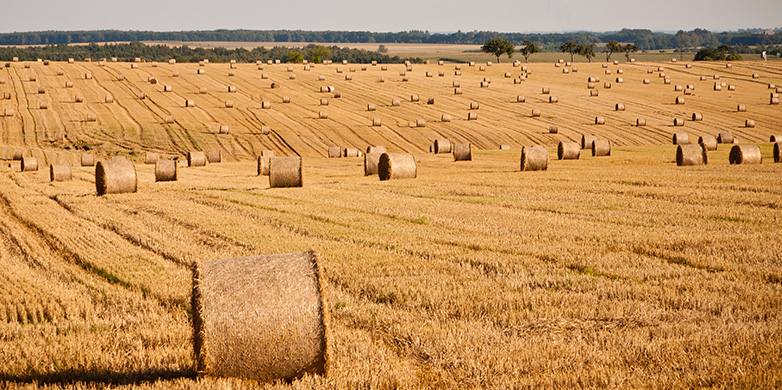Straw albedo mitigates extreme heat
Fields that are not tilled after crop harvesting reflect a greater amount of solar radiation than tilled fields. This phenomenon can reduce temperatures in heat waves by as much as 2 °C, as researchers from ETH have demonstrated in a recent study.
Wheat fields are often tilled immediately after the crop is harvested, removing the light-coloured stubble and crop residues from the soil surface and bringing dark bare earth to the top. Post-harvest tilling is a widely practised and common management technique in Europe. However, ploughed fields can have a negative effect on the local climate during a heat wave. This effect was addressed in a recent study conducted by researchers at ETH Zurich led by Edouard Davin, senior lecturer at the Institute for Atmospheric and Climate Science, and Sonia Seneviratne, professor of land-climate dynamics, which has now been published in the scientific journal PNAS.
Unploughed stubble is lighter in colour and reflects more solar radiation than tilled surfaces. Measurements taken show that approximately 30% of sunlight is reflected back due to the albedo effect – the albedo is a measure of the reflectance capacity of reflective surfaces. Ploughed fields reflect only 20% of incoming solar radiation. Model simulations have shown that this difference results in a 50% higher level of reflection in unploughed fields and that this in turn has a significant effect in extreme heat. In the event of a heat wave, such as the one in Europe in 2003, unploughed farm fields could reduce the local temperature by as much as 2 °C.
Regional effect
The hotter it becomes, the greater the albedo effect and the resulting temperature reduction. "Cropland albedo management has more effect during heat waves because there is almost no clouds during these events and more radiation can be reflected back into space", says first author Edouard Davin. However, this effect is only short term and local — perhaps at the most regional, but never trans-regional.
“In other words, if all French farmers were to stop ploughing up their fields in summer, the impact on temperatures in Germany would be negligible,” says Seneviratne. Leaving fields untilled would also have no noticeable effect over the long term on global warming trends and more frequent heat waves. Nevertheless, as Seneviratne points out, the local impact is important and could help break peak temperatures on extremely hot days.
Overall, says Seneviratne, no-till farming makes more sense in regions where summers are regularly very hot due to high levels of sun exposure e.g. in areas around the Mediterranean. Nonetheless, on heat days, the effect is also relevant in Central and Northern Europe. As part of the study, which was carried out jointly by the ETH researchers and French scientists, Davin analysed solar radiation measurements on farmland near the southern French city of Avignon. The researchers also conducted model simulations for Europe that incorporated the projected effect of unploughed cropland.
The scientists also report that the cooling effect of an unploughed field cannot be attributed solely to changes in albedo values. Crop residue acts as an insulating layer that holds back moisture from deeper soil strata and releases it only slowly — this long process of evaporation also helps reduce the air temperature during a heat wave. In a ploughed field, on the other hand, moisture evaporates more rapidly and almost completely in extreme heat. Thus, there is an additional cooling effect of no-till farming through slow evaporation.
No-till farming common in the Americas
The researchers believe no-till farming is a useful option in order to mitigate the local effects of climate change — for example, on extremely hot days in summer. “It is important that cropland albedo management can dampen heat waves because these events, although rare by definition, have a large impact on humans and ecosystems,” Seneviratne explains. Even though the rise in average global temperatures has stagnated in recent years, there has been an increase in extreme heat events over land areas.
Europe in particular has sufficient potential to use no-till farming as a tool to lower temperatures on hot days. Until now, European farmers have left only an extremely small portion of their fields unploughed after a harvest and globally the region accounts for only 2% of all unploughed cropland. The situation is very different in the US and South America, which account for 85% of the world’s unploughed farmland.
Literature reference
Davin EL, Seneviratne SI, Ciais P, Olioso A, Wang T. Preferential cooling of hot extremes from cropland albedo management. PNAS Early Edition, published online 23th June 2014. DOI: external page10.1073/pnas.1317323111call_made
Seneviratne SI, Donat M, Mueller B, and Alexander LV: No pause in the increase of hot temperature extremes. Nature Climate Change 2014. 4: 161-163. DOI: external page10.1038/nclimate2145call_made

